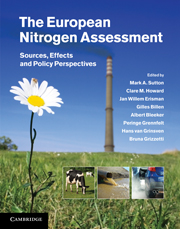Book contents
- Frontmatter
- Contents
- List of contributors
- Foreword
- Summary for policy makers
- Technical summary
- 1 Assessing our nitrogen inheritance
- Part I Nitrogen in Europe: the present position
- Part II Nitrogen processing in the biosphere
- Part III Nitrogen flows and fate at multiple spatial scales
- Part IV Managing nitrogen in relation to key societal threats
- Part V European nitrogen policies and future challenges
- Glossary
- Index
Summary for policy makers
Published online by Cambridge University Press: 16 May 2011
- Frontmatter
- Contents
- List of contributors
- Foreword
- Summary for policy makers
- Technical summary
- 1 Assessing our nitrogen inheritance
- Part I Nitrogen in Europe: the present position
- Part II Nitrogen processing in the biosphere
- Part III Nitrogen flows and fate at multiple spatial scales
- Part IV Managing nitrogen in relation to key societal threats
- Part V European nitrogen policies and future challenges
- Glossary
- Index
Summary
Main messages
Too much nitrogen harms the environment and the economy
Over the past century humans have caused unprecedented changes to the global nitrogen cycle, converting atmospheric di-nitrogen (N2) into many reactive nitrogen (Nr) forms, doubling the total fixation of Nr globally and more than tripling it in Europe.
The increased use of Nr as fertilizer allows a growing world population, but has considerable adverse effects on the environment and human health. Five key societal threats of Nr can be identified: to water quality, air quality, greenhouse balance, ecosystems and biodiversity, and soil quality.
Cost–benefit analysis highlights how the overall environmental costs of all Nr losses in Europe (estimated at €70–€320 billion per year at current rates) outweigh the direct economic benefits of Nr in agriculture. The highest societal costs are associated with loss of air quality and water quality, linked to impacts on ecosystems and especially on human health.
Nitrogen cascade and budgets
The different forms of Nr inter-convert through the environment, so that one atom of Nr may take part in many environmental effects, until it is immobilized or eventually denitrified back to N2. The fate of anthropogenic Nr can therefore be seen as a cascade of Nr forms and effects. The cascade highlights how policy responses to different Nr forms and issues are inter-related, and that a holistic approach is needed, maximizing the abatement synergies and minimizing the trade-offs.
[…]
- Type
- Chapter
- Information
- The European Nitrogen AssessmentSources, Effects and Policy Perspectives, pp. xxiv - xxxivPublisher: Cambridge University PressPrint publication year: 2011
- 21
- Cited by



